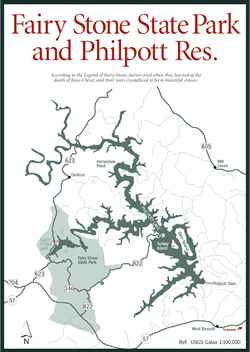 Fairy
Stone State Park
Fairy
Stone State Park  Fairy
Stone State Park
Fairy
Stone State Park [Fig. 36] There's a bit of magic in Fairy Stone State Park. The 4,670-acre park is one of only three known areas in the world where brown staurolite crystals were compressed under great natural heat and pressure to form shapes that suggest Maltese, Roman, or St. Andrew's crosses. The other two locations are Switzerland and the nearby mountains of North Carolina.
The "fairy stones," as they were called by Blue Ridge mountain people, were considered good-luck pieces and were worn or carried to ward off illness, accidents, and denizens of the nether world. Early Scots-Irish settlers also brought to Virginia the concept of trolls, spirits, and fairies. A mountain myth suggests that the brown, cross-shaped stones were fairy tears shed at the time of Christ's death and the tears turned to crystal when they fell to the ground. The manner in which the crosses were formed is better understood now. As the earth's crust heated, folded, and cooled during the formation of the Appalachian Mountain range, iron aluminum silicate—the basic ingredient of fairy stone crosses—crystallized into six-sided shapes. The staurolite crystals, like quartz and diamonds, are harder than surrounding materials. The crystals therefore erode slower and come to the earth's surface, retaining their original shape, as softer surrounding material washes away.
The fairy stone crosses are still sold today in the park and at nearby stores and service stations. Visitors can also search for their own fairy stones in the park along walking trails and old creek beds after hard rains have scoured away loose soil. Fairy Stone State Park lies in the gentle foothills of the Blue Ridge in Henry and Patrick counties. It opened in 1936 and was one of Virginia's original six state parks built by the Civilian Conservation Corps. The 168-acre Fairy Stone Lake is the park's centerpiece. Visitors can fish for bass, sunfish, channel catfish, and crappie. Game department samplings have turned up good numbers of largemouth bass in the lake, including some 8-pounders.
Read and add comments about this page